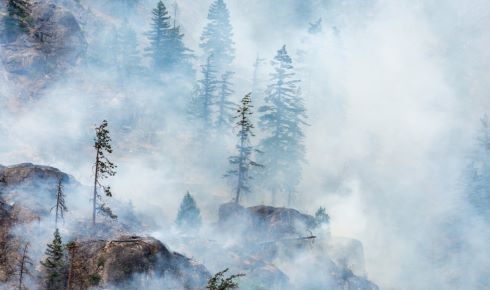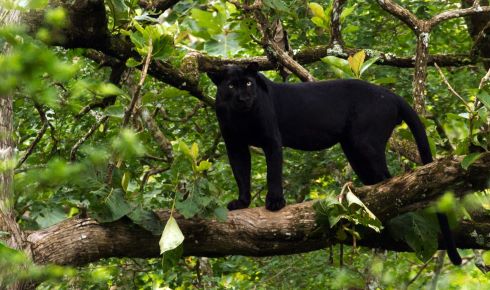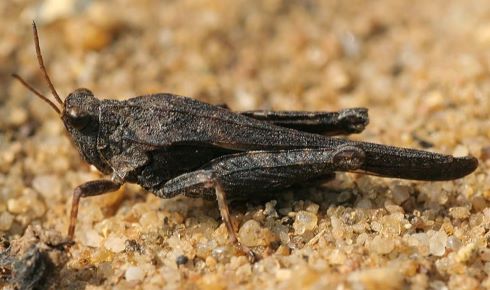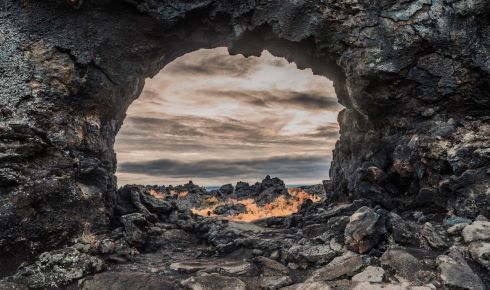What is 'fire melanism'?

6th September 2024
Richard Pallardy explores ‘fire melanism’ – the tendency for black or dark animals to become more common in burnt landscapes
In the classic Disney version of 101 Dalmatians, the titular spotted pups roll themselves in soot to disguise themselves from the villainous Cruella de Vil, who hopes to turn their pelage into a stylish coat. A number of animals have adopted this strategy in more natural environments, and more permanently – evolving darker forms to camouflage themselves from predators and even from prey.
Most famously, the peppered moth (Biston betularia) grew darker in regions of the UK soiled by industrial pollution, making it harder for avian predators to discern. In an inverse approach, black leopards (Panthera pardus), colloquially known as panthers, are more common in forested environments, where their colouration may help them blend in with the shadows and sneak up on unsuspecting herbivores. As Rudyard Kipling describes Bagheera, the black leopard in The Jungle Book, they are “inky black all over, but with the panther markings showing up in certain lights like the pattern of watered silk”.
Blending in
Black colouration may be especially helpful to animals that must make their way in more volatile, fire-driven ecosystems such as savannahs, where lightning strikes and other phenomena lead to frequent burns. The background colour against which they must camouflage themselves rapidly changes under these circumstances.
Whereas once the landscape was green or brown, in a matter of hours or days it becomes black, exposing animals that were once concealed by their emerald or tawny colourations. Especially in rapidly breeding species such as insects or rodents, natural selection encourages the emergence of darker forms that offer better concealment against the pitch-coloured substrate.
Melanism – the occurrence of darker colouration due to an increase in a dark pigment called melanin – occurs across the spectrum of animal life. The word derives from the Greek mélās, meaning black. Animals in which melanism occurs typically have variations in genes that encode the melanocortin 1 receptor (MC1R) or the agouti signalling protein (ASIP), though other genes may be involved as well. These genes direct the colour that the animal ultimately develops.
There are melanistic insects, fish, amphibians, reptiles, birds and mammals. Sometimes these melanistic colour forms are adaptive, and sometimes they are random, popping up as anomalies. Adaptive melanism may not always relate to camouflage – in one strange variation of industrial melanism, melanistic sea snakes in New Caledonia concentrate pollutants in their skins¹, which are later shed.
When fire chars the environment, a number of animals appear to adapt in short order. Grasshoppers are among the best studied. In several regions, these insects quickly evolve darker coloured forms after fires. These variations disappear just as rapidly when the scorched landscapes begin to recover and the colouration become less advantageous.
 A black panther, or melanistic leopard (Panthera pardus) in the forests of Nagarhole National Park, India. Courtesy of David V Raju and Wikimedia Commons
A black panther, or melanistic leopard (Panthera pardus) in the forests of Nagarhole National Park, India. Courtesy of David V Raju and Wikimedia Commons
Diversity of colour morphs
One study² found that 50% of pygmy grasshoppers (Tetrix subulata) in Sweden were melanistic in the year after a fire. The number dropped to 30% four years later. (Similarly, rates of melanistic peppered moths have decreased as the effects of industrial pollution have been mitigated over time.)
While some early research on the subject from the 1950s indicated that there may be some plasticity in the expression of melanism³ when grasshoppers are faced with a newly darkened environment, other studies show that fire melanism in these insects is an immutable trait. It is, of course, difficult to ascertain whether the prevalence of darker coloured grasshoppers is because lighter ones are being eaten or because they are simply leaving the area.
One of the downsides of black colouration is the greater absorption of heat. Melanistic grasshoppers seem to prefer higher temperatures, suggesting that other genetic adaptations are linked to the hue of their exoskeletons.
Another examination of the same species⁴ in Sweden found that following the initial surge of melanistic individuals in the wake of a fire, an increased diversity of colour morphs emerged. This suggests that the species may evolve different colour patterns in response to the changes that occur as vegetation regenerates and creates a patchwork of shades against which a variety of body colours might serve as camouflage.
Several species of African grasshopper found in regions with frequent fires also exhibit melanistic forms⁵ following a burn, as does a species from South America⁶. Melanistic forms of other insects emerge in response to fire as well, notably two species of African mantis, a noctuid moth larva and a pentatomid bug.
 One study found that 50% of pygmy grasshoppers (Tetrix subulata) in Sweden were melanistic in the year after a fire
One study found that 50% of pygmy grasshoppers (Tetrix subulata) in Sweden were melanistic in the year after a fire
Shades of grey
Fire melanism has even be seen in some rodent species. A study of eastern fox squirrels (Sciurus niger) in Florida found that semi-melanistic agouti colourations were more prevalent in fire-prone ecosystems⁷. These squirrels display a high degree of polymorphism, with colourations ranging from grey to completely black individuals. Because burnt ecosystems only remain black for a short period before vegetation recovers, the authors suggest that intermediate levels of melanism are most adaptive in these heterogeneous, highly variable areas – aligning with the panoply of shades in the grasshoppers. Squirrels that inhabit croplands, however, tend to be lighter in colour.
With the main threat to squirrels coming from airborne predators, it is thought that the darker forms help conceal individuals among the blackened trees they live in and around. Even Arctic ground squirrels (Urocitellus parryii), also appear to develop melanistic forms in response to fire⁸.
There is some suggestion that even larger mammals may adapt to scorched environments through melanistic variations in coat colour. A recent study on bobcats (Lynx rufus)⁹ in the Everglades of Florida found that a small proportion were pure black – an intriguing development in an ecosystem frequently ravaged by fire. Of 9,503 camera trap photographs of bobcats, 25 captured melanistic individuals. Given the technology deployed, it was difficult to discern how many specimens were actually depicted. Though burnt landscapes here are quickly revegetated, if they are burnt often, so being black might be useful.
“Florida has the shortest fire return interval in the United States,” said lead author Aidan Branney, a PhD student at the University of Georgia-Athens. “It could play a role. If you look at the historical records of melanistic bobcats in Florida, it suggests that the pyrrhic landscape might drive this phenotype.”
Wildfires or inbreeding?
Another study¹⁰ has suggested that a melanistic giant anteater (Myrmecophaga tridactyla) found in Brazil may have emerged as the result of wildfires – though for a very different reason. While the colouration could be adaptive in a blackened environment, the mutation may also have arisen due to population fragmentation and resultant inbreeding, which can lead to the emergence of anomalous characteristics. The same researchers describe an albino anteater from another region in Brazil affected by fire, indicating that these rare forms may develop due to small breeding populations.
 Animals that live in volcanic areas may also exhibit melanism
Animals that live in volcanic areas may also exhibit melanism
In a fascinating related phenomenon, animals that live in areas affected by volcanism may exhibit similar rates of melanism. Barn owls (Tyto alba) found in volcanic regions have darker plumage – and research has suggested that their colouration may actually be affected by the sulphur found in volcanic soils¹¹. The form of melanin found in their feathers contains sulphur compounds, suggesting that exposure to these soils may influence their hue.
Rock pocket mice (Chaetodipus intermedius) in south-west US are also more commonly melanistic when they occur on lava fields¹². Strangely, different populations have developed melanism through separate pathways – some by alterations to the MC1R gene and others through an unidentified gene. It seems melanism was so advantageous under these circumstances that it emerged twice. Several species of beetle collected from a volcanic slope in Mexico were found to be melanistic as well¹³.
Even animals that do not develop melanistic variations in response to fires may take advantage of these novel ecosystems. Western fence lizards (Sceloporus occidentalis) prefer to roost on carbonised plant stems after fires, for example, and greater rheas (Rhea americana) blend perfectly into burnt savannahs.
There appear to be many other advantages to melanism, depending on the environment. Melanistic fur may be stronger, making it more resistant to damage by movement through thick brush, for example. Gloger’s rule states that mammalian and avian melanism is more common in hot and humid regions, a result of the need for protection from more intense UV solar radiation, and the greater resilience of black feathers against humid conditions. However, in contrast to Gloger’s rule, a phenomenon known as thermal melanism increases at higher latitudes. Darker-coloured animals are better at absorbing heat – an edge in chilly climates. (Greater UV protection can be needed at altitude, too.)
So it is that Earth’s inkiest creatures are formed by extremes: cold, heat, punishing conditions and, in the case of a select cohort of grasshoppers and squirrels and mice and even bobcats, almost literally forged by fire. As Earth continues to warm and wildfires increase, it seems conceivable that these adaptations may emerge in an increasing number of animals in affected environments.
References
1) Lallensack, R. Sea snakes lose their stripes to deal with pollution. Nature (2017).
2) Forsman, A. et al. Rapid evolution of fire melanism in replicated populations of pygmy grasshoppers. Evol. 65(9), 2530–2540 (2011).
3) Burtt, E. The ability of adult grasshoppers to change colour on burnt ground. Proceedings of the Royal Entomological Society of London. Series A, General Entomology 26(4–6), 45–48 (1951).
4) Karlsson, M. et al. Dynamics of colour polymorphism in a changing environment: fire melanism and then what? Oecologia 154, 715–724 (2008).
5) Hocking, B. Fire melanism in some African grasshoppers. Evol. 18(2), 332–335 (1964).
6) de Alcantara Viana, J., Brito, V. & Melo, C. Colour matching by arthropods in burned and unburned backgrounds in a neotropical savanna. Austral. Ecol. 47(1), 1427-1437 (2022).
7) Potash, A. et al. Ecological drivers of eastern fox squirrel pelage polymorphism. Frontiers Ecol. Evol. 8(119) (2020).
8) Guthrie, R. Fire melanism among mammals. American Midland Naturalist 77(1), 227–230 (1967).
9) Branney, A. et al. Photographic documentation of melanism in bobcats (Lynx rufus) in the Greater Everglades. Ecol. Evol. 14(1) (2024).
10) Cotts, L. & Serodio Prestes, S. First report and description of melanism and albinism in giant anteater, Myrmecophaga tridactyla (xenarthra, myrmecophagidae). Oecologia Australis 26(4). 637–645 (2022).
11) Romano, A. et al. Island volcanism predicts pheomelanin-based plumage colouration in a cosmopolitan raptor. J. Biogeography 50 1669–1678 (2023).
12) Majerus, M. & Mundy, N. Mammalian melanism: natural selection in black and white. Trends in Genetics 19(11), 585–588 (2003).
13) Selander, R. Melanism in some Meloidae (Coleoptera) from the Pinacate Lava Cap in northwestern Sonora, Mexico. Transactions of the Kansas Academy of Science 61(1), 77–80 (1958).
Richard Pallardy is a researcher and writer with a particular interest in zoology, botany, evolution and conservation.


